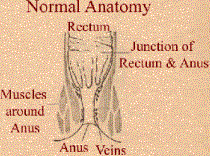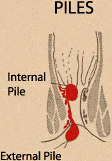
WHAT ARE PILES?
You must have seen engorged, bluish veins behind the legs of certain
women called Varicose veins. Now imagine a similar bunch of veins
at the anal opening or lower part of the rectum known as Piles.
SEX OR AGE MOST AFFECTED
Adults of both sexes, but many women get affected after childbirth.
SIGNS & SYMPTOMS
- Rectal bleeding. Bright-red blood may appear as streaks adhering to stools, or it may be
a slow trickle for a short while after passage of stools.
- Pain, itching or mucus discharge during/after passage of stools.
- A lump that can be felt in the anus.
- A sensation that the rectum has not emptied completely after passage of stools (only in
large piles).
CAUSES
Repeated pressure in the anal or rectal veins--usually caused by
straining that could be
- due to constipation
- while urinating due to prostate enlargement, in men
- during labor
- due to pressure of enlarged uterus.
RISK INCREASES WITH
- Diet that lacks fiber; constipation.
- Prolonged sitting.
- Obesity.
- Pregnancy.
HOW TO PREVENT
- Don't try to hurry bowel movements.
- Lose weight if you are overweight.
OTHER
Straining during bowel movements increases pain.
DIAGNOSTIC MEASURES
- Suggestive symptoms.
- Detailed history and examination by a doctor.
- Proctoscopy or sigmoidoscopy.
POSSIBLE COMPLICATIONS
- Iron-deficiency anemia if blood loss is
significant.
- Severe pain caused by a blood clot in a hemorrhoid.
- Infection or ulceration of a hemorrhoid.
TREATMENT
GENERAL MEASURES
- Never strain while passing stool.
- Keeping feet on a low footstool may aid defecation.
- Clean the anal area gently with water each time you pass stool. Using dry toilet paper
will aggravate the condition
- To relieve pain, take sitz bath several times a day.
- In case of a blood clot or thrombosed pile, stay in bed and apply ice packs to the anal
area, to reduce swelling and pain.
- Surgery may be required to remove hemorrhoids.
SURGICAL OPTIONS
MEDICATION
There is NO medical treatment.
- For minor pain, you may use non-prescription ointment.
- Your doctor may prescribe a stool softener or bulk laxative, such as Isabgol .
ACTIVITY
No restrictions. Bowel function improves with good physical
conditioning.
DIET
To prevent constipation, eat a well-balanced diet that contains
many high-fiber foods
such as fresh fruit, vegetables and whole-grain cereals.
CONTACT YOUR DOCTOR
- A hard lump develops where a pile has been.
- Severe pain that isn't relieved by treatment above.
- Rectal bleeding is excessive (more than a trace or streak).
FAQ's |

